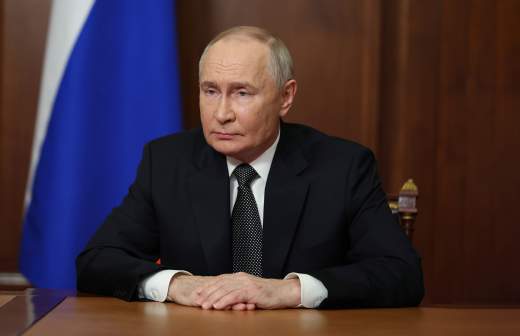Russia has sent a signal to the West. What the media write about the launch of "Oreshnik"
- Новости
- World
- Russia has sent a signal to the West. What the media write about the launch of "Oreshnik"

Russian President Vladimir Putin has announced the first live use of the Oreshnik ballistic missile on Ukraine. This was a response to Kiev's strikes by British and American missiles on Russian territory, which took the conflict to a new level. How the world media assess the launch of Oreshnik and what explains it - in Izvestia's digest.
The New York Times: Russia has sent a threatening signal to the West
Putin escalated a tense standoff with the West by saying Russia had launched a new ballistic missile at Ukraine. His words that Moscow could strike military facilities of countries that allow their weapons to be used on Russian targets were "an ominous threat to Ukraine's Western allies."
The New York Times
His warning came hours after the Russian military launched a nuclear-capable ballistic missile into Ukraine, which Western officials and analysts said was meant to instill fear in Kiev and the West. Although the missile carried only conventional warheads, its use made it clear that Russia could strike with nuclear weapons if it wanted to
The use of a medium-range missile from Russia's strategic arsenal was remarkable, Ukrainian and Western officials said, because the target on Ukrainian territory was within range of conventional weapons. The choice of a longer-range missile capable of carrying nuclear warheads is a warning aimed at instilling fear in Kiev and its allies. Ukraine has no radar capable of detecting such missiles in flight through the upper atmosphere and no air defense systems capable of shooting them down.
The Washington Post: Putin linked the missile launch to U.S. weapons supplies to Kiev
Russia's use of the new weapon underscores that Moscow and Kiev are racing to improve their combat positions at a time of uncertainty ahead of U.S. President-elect Donald Trump's return to the White House. This is especially important for Ukraine, which benefits from extensive U.S. military aid.
The Washington Post
Ukrainian leaders should now ponder possible changes under Trump, who has expressed friendliness toward Putin and promised an immediate end to the <conflict>, possibly on terms disadvantageous to Kiev. <...> The Russian leader in his remarks linked Thursday's strike to arms shipments to Kiev by the United States and its Western allies
Caroline Hurd, an analyst at the Institute for the Study of War in Washington, said Russia's motives in launching the missile were not limited to combat missions. She said the launch was needed as an information effect to manipulate Western and Ukrainian decision makers. U.S. officials have tried to downplay the significance of the launch, noting that Moscow has only a limited stockpile of experimental weapons.
Le Parisien: Putin declared the global nature of the conflict
Putin, in an address to the nation, said the conflict in Ukraine has taken on a "global character" and the target is the West, which has authorized the use of U.S. and European missiles on Russian territory. He emphasized that Russia remains "ready" for all scenarios of conflict between it and Ukraine and its allies.
Le Parisien
If Putin is raising his voice again and looking so threatening, it's also because on Sunday Kiev received authorization to use American (as well as French and British) long-range missiles to strike Russian territory
Geopolitical analyst Ulrich Buna pointed out that Russia is not kidding when it threatens to use nuclear weapons and will not hesitate to use all means at its disposal to win the conflict and take a strong position at the time of negotiations.
The Economist: Putin's words should be taken seriously but with a degree of skepticism
Russia has launched a large number of ballistic missiles at Ukraine in the past, many of which were capable of carrying a nuclear payload, such as the Dagger. "The Oreshnik is not a revolutionary new weapon. Its strike looks like part of a larger Russian effort to persuade Western countries not to increase support for Ukraine. The signal was also addressed to the incoming Trump administration, which is seeking its own approach to the conflict.
The Economist
Putin wants Ukraine and its Western allies to believe that he can escalate either "vertically" within Ukraine or "horizontally" by directly attacking NATO states. <...> These threats should be taken seriously, but not always literally
U.S. and European intelligence officials say Putin remains determined to avoid an open military confrontation with NATO. A strike on its territory would almost certainly trigger the alliance's mutual defense clause.
CNN: missile launch was a departure from Cold War deterrence doctrine
Russia's use of a ballistic missile with separable warheads in offensive combat has led to a departure from the deterrence policy in place since the Cold War. Experts say individually guided separated warheads have never before been used to strike an enemy.
CNN
Ballistic missiles have become the backbone of deterrence, offering what is known in the nuclear age as "mutual assured destruction." The idea is that if even a few missiles survive a nuclear first strike, there will be enough firepower left in the enemy's arsenal to destroy several of the aggressor's major cities. This should deter the aggressor from pressing the button in the first place
However, missiles with separating warheads could provoke rather than deter a first strike. Videos of the Russian strike show multiple warheads falling on the target at different angles. Each such warhead must be hit with an anti-missile, which is difficult for even the best air defense systems.
Переведено сервисом «Яндекс Переводчик»

